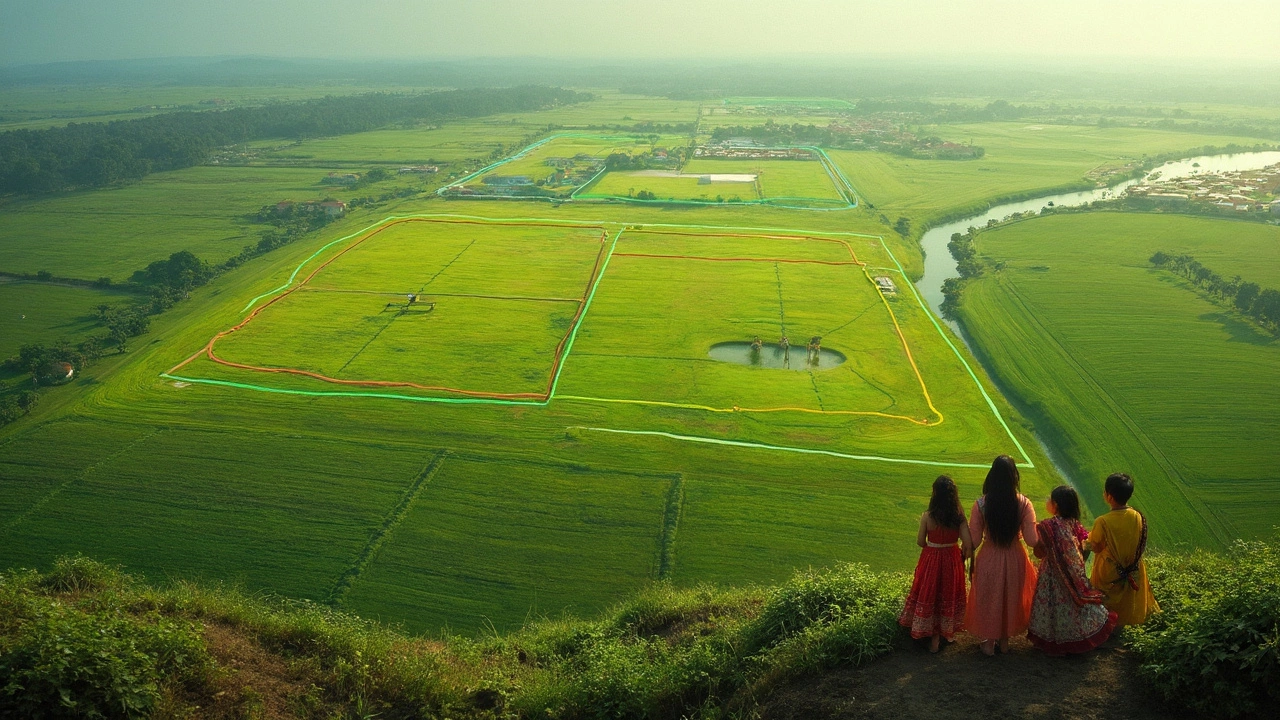Trying to picture 100 acres can make your head spin. Unless you grew up measuring land for a living, the number probably feels abstract. Now, if you compare it to football fields, things start to click. Americans love using sports fields as a size reference—nothing beats a visual you can actually relate to.
Let’s get practical: a standard American football field, including the end zones, covers about 1.32 acres. That means 100 acres is about 75 full football fields side by side. Imagine walking from one goalpost to another—now try doing that 75 times in a row without stopping. That’s a ton of space.
People use land this size for all sorts of things: hunting retreats, mini-farms, solar projects, or private parks. If you’re looking at buying, knowing how it stacks up to something familiar can spare you buyer’s remorse. Skip the guesswork—when someone tells you 100 acres, think “a stadium packed with 75 football fields,” not just a bunch of empty grass.
- Doing the Math: Acres vs. Football Fields
- What 100 Acres Looks Like in Real Life
- Why Compare Land to Football Fields?
- Tips for Evaluating Large Land Parcels
Doing the Math: Acres vs. Football Fields
Let’s break it down so you don’t have to Google conversions every time you hear the words “100 acres.” One acre is 43,560 square feet. Now, a standard American football field measures 360 feet long by 160 feet wide, which totals 57,600 square feet. But that number includes the end zones. In reality, the area that counts—the field plus the two 10-yard end zones—is what we usually picture: 360 by 160 feet, or 1.32 acres.
This makes things simple: if one football field is 1.32 acres, all you have to do is divide your total acreage by this number.
- 1 acre = 43,560 sq ft
- 1 football field (with end zones) = 57,600 sq ft
- 1 football field (in acres) = 57,600 / 43,560 ≈ 1.32 acres
- 100 acres / 1.32 ≈ 75.76 football fields
Here’s a quick cheat sheet so you can size up any land deal fast:
| Size | Square Feet | Football Fields (Rounded) |
|---|---|---|
| 1 Acre | 43,560 | 0.76 |
| 5 Acres | 217,800 | 3.8 |
| 10 Acres | 435,600 | 7.6 |
| 50 Acres | 2,178,000 | 38 |
| 100 Acres | 4,356,000 | 76 |
If you ever want to impress someone at a showing, just say, “So, 100 acres is basically 76 football fields.” Most people will get the idea right away. This makes it way easier to imagine, whether you’re buying, selling, or just curious about land for sale in your town.
What 100 Acres Looks Like in Real Life
If you stood at one corner of a 100-acre property, you’d probably lose sight of someone waving at you from the opposite end. It’s huge. To put things in perspective, imagine a property that stretches for roughly 2,420 feet by 1,800 feet if it’s shaped like a rectangle. That’s enough space to fit a small neighborhood.
Here’s a crazy stat: Disney’s Magic Kingdom in Orlando is about 107 acres. So, 100 acres is nearly the size of that entire theme park. That’s more than enough room for a big family farm, a campgrounds operation, or even your own private golf course.
| Landmark/Use | Approximate Size (Acres) |
|---|---|
| Standard Football Field | 1.32 |
| Costco Store (average property) | 13 |
| Walmart Supercenter (building + parking) | 20 |
| Disney Magic Kingdom | 107 |
| Central Park, New York (entire park) | 843 |
If you’re thinking about buying 100 acres of land, keep in mind what that really means in daily life:
- Walking the perimeter once is nearly a two-mile hike.
- You could split the land into 20 five-acre “mini estates” and still leave room for trails or common areas.
- Running utilities across that much land could take time and money, so plan for things like road access and power lines.
You’d have space for a big garden, ATV trails, paddocks, or even a small herd of cattle. The truth is, most people never set foot on all 100 acres they own unless they’re actively farming or running outdoor activities. But having that much space? The privacy and options it brings are game changers.

Why Compare Land to Football Fields?
Let’s be honest: acres just don’t pop into your head as something you can see or touch. Football fields, though? Most people have stood on one or at least watched a game on TV. That’s why using a football field as a measuring stick is the go-to move—even realtors do it when talking about big plots.
This isn’t just a sales trick. A standard American football field, including the end zones, measures 360 feet long and 160 feet wide. That’s 57,600 square feet, or about 1.32 acres per field. It’s a unit people recognize and can actually visualize without a calculator.
Here’s the real kicker: when land deals get big, numbers get muddy fast. If you ask two people off the street how big 100 acres is, you’ll get shrugs. Ask them about 75 football fields lined up, suddenly they start to get it. As Dr. James Farmer, an urban planning professor, once said:
"People relate better to familiar things. Comparing large plots to recognizable spaces like football fields helps buyers actually picture what they’re getting."
Using this approach makes open land easier to compare, whether you're looking at two properties for sale or just trying to explain to your cousin how big your latest hunting spot is. The key is simplicity. Nobody pulls out a measuring tape in the middle of a field, but everyone gets the size of a football field.
That’s why if you’re eyeing a 100 acres property, forget the technical math—just mentally stack those fields. This trick not only keeps you from getting overwhelmed but could save you from a nasty case of overestimating your next big purchase.
Tips for Evaluating Large Land Parcels
Looking at a big piece of land, like 100 acres, can be overwhelming. It’s not just about the price or the location. There are a bunch of things you want to check up front so you don’t end up with regret or hidden problems later on. Here are some smart steps to take when you’re weighing up a large property.
- Check the Zoning and Restrictions: Find out what you’re actually allowed to do with the land. Counties use zoning laws to control what can be built (residential, commercial, agricultural). If your dream is farming but it’s zoned for residential only, you’ll hit a wall fast.
- Access and Road Frontage: Make sure there’s easy access from a public road. Some big parcels are “landlocked”—meaning you can’t legally reach them without crossing someone else’s property. Drive by the land in person, and don’t just rely on Google Maps.
- Water and Utilities: It’s common for big parcels to need well water and septic systems. Double check if electricity runs to the land or if you’ll need to pay the utility company to hook you up—this can easily cost tens of thousands of dollars.
- Topography and Flood Risk: Scope out the lay of the land—literally. Is it flat, hilly, wooded, or rocky? Is any of it in a FEMA floodplain? Useless acres in a swamp or ravine are a waste of money unless that’s what you actually want.
- Environmental Issues: Have the soil tested if you plan to build or grow anything. Check for protected wetlands or endangered species habitat, since that could limit building or development.
Here’s a snapshot of what experienced buyers look for when picking out large parcels:
| Feature | Why It Matters | How to Check |
|---|---|---|
| Legal Access | Without road access, land value drops | Get a title search from a lawyer or title company |
| Zoning | Controls what you can legally do with the land | Contact county zoning office |
| Utilities | Adds major cost if missing | Ask local utility providers |
| Soil Quality | Impacts farming or building plans | Get a professional soil test |
| Water Source | Key for living or livestock | Check for wells, ponds, or streams |
| Surrounding Land Use | Affects privacy and long-term value | Visit the area and check public records |
Finally, when you walk a parcel this size, take a buddy. Large tracts are easy to get lost on, and cell service isn’t always a given. Use GPS so you don’t end up trespassing by accident. If you’re serious about the property, bring in a surveyor to make sure those 100 acres are really what you’re paying for—and not missing a chunk. That’s the difference between “almost enough room” and the 100 acres you’re after.
